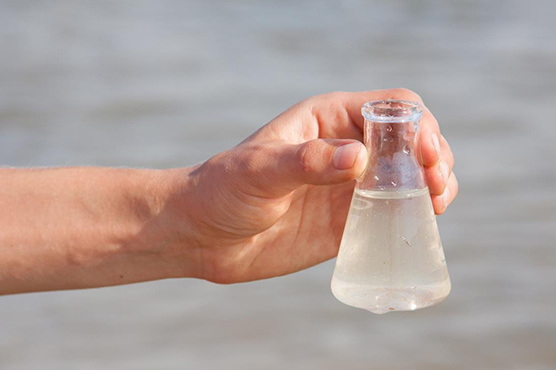Researchers develop device to remove '100pc' of salt from seawater

So, what we have here is a desalination method that's cheap, practical, and effective.
(Web Desk) – Finding cheap and practical ways of removing salt from seawater could potentially help some of the 844 million people worldwide without regular access to clean water – and scientists just found a new nanoscale method for doing just that.
Using a tiny disc made of super-hydrophilic filter paper, layered with carbon nanotubes for light absorption, the new technique runs on nothing but sunlight, but is able to remove almost 100 percent of the salt in the original liquid.
The new approach is based on a traditional method: heat water until it steams and capture that, leaving the salt and other impurities behind. To turn water into steam using energy from our Sun, one needs to use solar thermal materials to efficiently convert that energy into heat.
But if these materials are covered by salt crystals from the evaporating water, the whole thing can grind to a halt. The new method successfully addresses this problem by maintaining a steady rate of water evaporation as the salts are harvested and removed from the process, to avoid them reducing efficiency.
So, what we have here is a desalination method that’s cheap, practical, and effective. Because it’s powered by sunlight, devices using this technique could be particularly useful in places without reliable access to electricity.
"Our study results advance one step further towards the practical application of solar steam generation technology, demonstrating great potential in seawater desalination, resource recovery from wastewater, and zero liquid discharge," says chemical engineer Xiwang Zhang, from Monash University in Australia.
"We hope this research can be the starting point for further research in energy-passive ways of providing clean and safe water to millions of people, illuminating environmental impact of waste and recovering resource from waste."
The new system uses a 1 millimetre (0.04 inch) diameter cotton thread to transport salty water to the evaporation disc, where the pure water is trapped and the salts are pushed out towards the edges.
This is all powered by sunlight, and in tests the researchers measured light absorbance of over 94 percent across the entire solar spectrum – so it makes good use of whatever sunlight happens to be available.
As Zhang told New Atlas, the innovative new device is capable of producing 6-8 litres (or 1.6-2.1 gallons) of clean water per square metre (10.8 square feet) of surface area per day. Next, the scientists want to up that production rate.
It’s not the only interesting desalination approach we’ve seen lately; last year, a team from the US produced a hydrogel-based, solar-powered technique for removing salt from seawater that is powerful enough to work on water taken from the Dead Sea.
The challenge now is to scale up such methods to make them practical – both in terms of putting the systems in place and in terms of how much water they can process.
"Water security is the biggest challenge the world faces in the 21st century, especially as population grows and the effects of climate change take shape," says Zhang. "Developing and under-resourced communities feel the effects of these factors the most."
"Utilising solar energy for water treatment has been widely considered as one of the sustainable solutions towards addressing the scarcity of clean water in some communities, without sacrificing our environment or resources."
The research has been published in Energy & Environmental Science.

